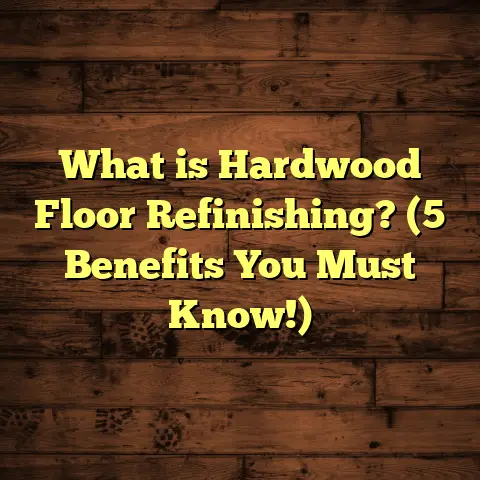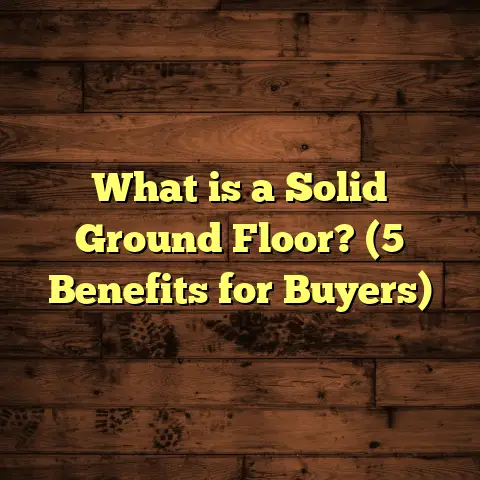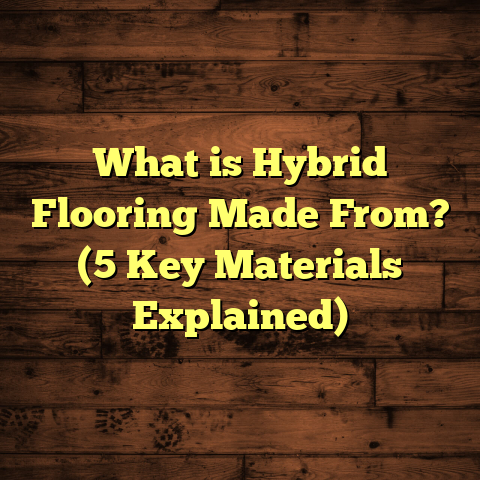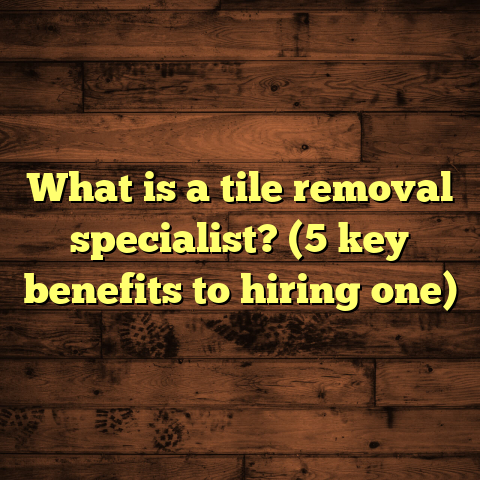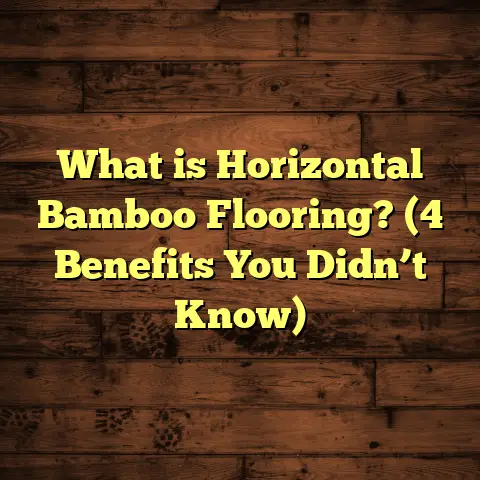What is Vinyl vs. Laminate Flooring? (5 Key Cost Factors Revealed)
Shocking fact: Vinyl and laminate flooring together make up over 70% of all residential flooring installations in the U.S., yet many homeowners don’t fully understand how they differ or what really drives their costs. Early in my flooring career, I noticed clients often made decisions based on price alone or surface looks without knowing what would serve their homes best long-term. Over time, I learned the key differences between these two popular options and what affects their costs most. So, I want to walk you through a deep look at vinyl vs. laminate flooring and reveal five key cost factors that will help you make a smart choice.
What is Vinyl Flooring and Laminate Flooring?
Let’s break down what these materials really are since understanding them is the foundation for everything else.
Vinyl flooring is a synthetic product made mainly from polyvinyl chloride (PVC). It comes in sheets, tiles, or planks. One of vinyl’s biggest strengths is its water resistance. The top layer of vinyl floors is usually a clear wear layer that protects a photographic film layer underneath—this layer gives the floor its design pattern, whether it’s wood grain, stone, or tile look. Below that is a core layer that adds durability and stability. Because vinyl is waterproof, it’s great in areas prone to moisture like kitchens, bathrooms, basements, and laundry rooms.
I remember when I installed vinyl flooring for a client in their basement that had some moisture issues from outside seepage. The vinyl held up perfectly, no swelling or warping happened even after heavy rains caused some dampness. That’s when I realized how well vinyl can handle moisture compared to other materials.
Laminate flooring, meanwhile, is also a synthetic product but built differently. It has four layers:
- A clear wear layer on top for protection against scratches and stains.
- A design layer below that which is a high-resolution photographic image of wood or stone.
- A core layer made of high-density fiberboard (HDF)—compressed wood fibers mixed with resins.
- A backing layer that provides stability and protects against moisture from underneath.
Laminate flooring is very durable and scratch-resistant but it’s not inherently waterproof because of that wood fiber core. If exposed to standing water or high humidity for long periods, it can swell or warp.
When I first worked on installing laminate flooring, I saw how precise the cuts had to be around door frames and corners because the planks lock together tightly but don’t tolerate much movement or moisture.
So to sum that up simply: vinyl is waterproof plastic-based flooring, while laminate is wood-fiber based flooring designed to look like real wood.
Material Composition and Durability Differences
Now that you know what each material is made of, let me share some details on how their composition impacts durability and performance.
Water Resistance: Why It Matters
Vinyl’s PVC core makes it naturally water resistant. This means spills, wet shoes, pet accidents, or even flooding won’t damage the floor easily. In fact, many vinyl products are fully waterproof. That’s why I recommend vinyl in any rooms where moisture is a concern.
Laminate’s HDF core is very different. It absorbs water like a sponge if exposed too long. This can cause the planks to swell, buckle, or even delaminate (layers come apart). Some newer laminates have water-resistant coatings or cores but they still don’t match vinyl’s waterproof properties.
One time, a homeowner called me after their laminate floor near a kitchen sink started buckling because of a slow water leak they didn’t notice for weeks. Vinyl would have been far more forgiving in that spot.
Scratch Resistance and Wear
Laminate floors generally have thicker wear layers than vinyl, making them better at resisting scratches and dents from pets’ claws or moving furniture. I’ve worked with families who preferred laminate because it looked better longer despite heavy foot traffic and pets.
Vinyl wear layers are thinner but more flexible, so they don’t crack easily but can show surface scratches if not cleaned carefully. That said, luxury vinyl planks (LVP) with embossed textures now offer excellent scratch resistance close to laminate quality.
Installation Flexibility
Vinyl offers several installation options: sheet vinyl can be glued down, while luxury vinyl planks or tiles often have click-lock systems that float over subfloors. This makes installation more versatile and sometimes easier for DIYers.
Laminate almost always uses floating installation with click-lock planks over a moisture barrier and underlayment to reduce noise and cushion steps. It requires very flat subfloors because unevenness can cause gaps or damage.
Longevity Expectations
Vinyl floors typically last 10-20 years depending on quality and maintenance. Laminate floors can last 12-25 years if kept dry and cared for well.
From my experience on site visits years after installation, I’ve seen older vinyl floors still looking decent despite heavy use, while laminate can look brand new if protected from moisture and scratches.
5 Key Cost Factors You Should Know About
Let’s dig into what really drives the cost differences between vinyl and laminate flooring. Knowing these will help you budget better and avoid surprises.
1. Material Price: What You Pay Per Square Foot
Material cost usually comes first to mind when choosing flooring.
- Vinyl flooring costs range from roughly $2 to $7 per square foot.
- Basic sheet vinyl is cheapest ($2–$3/sq ft).
- Mid-range luxury vinyl planks with realistic textures are $3–$5/sq ft.
- High-end LVP with thick wear layers and embossed patterns can go up to $7/sq ft.
- Laminate flooring ranges from about $1.50 to $5 per square foot.
- Entry-level laminates with thin cores start around $1.50-$2.
- Mid-range laminates with thicker cores and better designs run $2-$3.
- Premium laminates with enhanced durability go up to $5/sq ft but rarely exceed high-end vinyl prices.
I once helped a client who was on a tight budget choose between cheap laminate and mid-range vinyl. The laminate was about $1 less per sq ft material cost but they chose vinyl because of moisture concerns in their basement apartment. They happily paid the extra for peace of mind.
2. Installation Costs: Labor & Preparation
Installation expenses vary based on method, subfloor condition, and location labor rates.
- Vinyl installation typically runs $1.50 to $3 per square foot.
- Sheet vinyl needs glue-down or loose lay.
- Luxury vinyl plank installs faster with floating click systems.
- Laminate installation costs range from $2 to $4 per square foot.
- Requires flat, dry subfloors.
- Usually floating installation over underlayment.
- Sometimes requires floor leveling before install—adds $300-$1,000 depending on room size.
I did an installation where the concrete slab needed leveling before laminate could be installed properly—adding nearly $600 extra—but skipping this would have led to warped planks within months.
Also remember that removing old flooring can add $1–$3 per sq ft depending on material and difficulty.
3. Maintenance Costs Over Time
While upfront costs matter, what you spend on upkeep matters too.
- Vinyl floors require simple maintenance:
- Regular sweeping.
- Damp mopping with mild cleaners.
- Occasional resealing rarely needed (some sheet vinyl).
- Laminate cleaning is similar but requires:
- Avoiding standing water at all costs.
- Using special laminate floor cleaners.
If damage occurs:
- Vinyl repairs are usually patchwork or plank replacement.
- Laminate damaged planks often require full replacement of affected boards—sometimes tricky if discontinued styles.
Over 10 years, vinyl maintenance tends to be cheaper due to fewer repairs from water damage or scratches.
4. Waste Factor & Material Overruns
You never buy exactly one-to-one material; there’s always waste during cutting and fitting.
- Vinyl waste factor averages 5-7%.
- Laminate waste factor tends to be higher: 7-10%.
This happens because laminate needs precise cuts for tight seams; mistakes or mishandling during installation cause more scrap.
In one recent job with complex room shapes and multiple doorways, the laminate waste factor pushed material orders up by 10%, adding $350 extra on a $3,500 order.
5. Environmental Impact & Home Resale Value
Environmentally conscious buyers ask about floor sustainability.
- Vinyl uses PVC plastic—manufacturing involves chemicals with environmental impacts.
- New low-VOC (volatile organic compound) vinyl products reduce indoor air quality concerns.
- Laminate uses wood fibers and resins—less plastic but still synthetic.
- Some brands use sustainable wood sources and low-emission adhesives.
Regarding resale value:
- Laminate tends to be perceived as more upscale than vinyl because it simulates real hardwood more closely.
- However, luxury vinyl plank (LVP) has closed this gap considerably with realistic textures.
In my experience consulting with real estate agents:
- Quality installation matters more than material choice for resale.
- A well-maintained vinyl or laminate floor won’t harm home value; poor installation or low-quality floors can turn buyers off.
Personal Stories From My Flooring Career
I want to share a few stories from my experiences that illustrate how these factors play out in real life:
Basement Flooring Rescue: Vinyl Wins
A client called me frantic because their laminate floor in the basement was swelling after heavy rains caused water seepage under the slab. They had spent over $4,000 on the laminate installation less than a year ago. I recommended replacing it with waterproof luxury vinyl plank (LVP).
We removed the damaged laminate, sealed the subfloor with waterproofing paint, then installed LVP planks with a click-lock floating system over an extra moisture barrier pad.
The client was thrilled — no further moisture issues after two years despite heavy rain seasons — saving thousands in future repairs.
Family Home Flooring Choice: Scratch Resistance Counts
Another family had two dogs who scratched their floors often. They chose high-end laminate for durability against claws rather than vinyl. Though initial cost was slightly higher by about $0.50 per sq ft including install, the scratch resistance meant fewer repairs or refinishing needed over five years compared to friends who chose vinyl in similar homes.
Budget Apartment Makeover: Cost Efficiency
I worked on several apartments where clients wanted quick upgrades on tight budgets. Sheet vinyl was the go-to choice — cheapest material plus fast glue-down install cut labor costs significantly versus laminate floating installs requiring floor prep.
These projects showed me how cost factors beyond just material price—installation speed, waste minimization—are big parts of overall project budgeting.
How to Approach Choosing Flooring for Your Home?
Let’s keep it simple with some questions you should ask yourself:
- Does your space get wet often? Think kitchens, bathrooms, basements.
- Do you have pets or kids who might scratch or dent floors?
- What’s your total budget including materials + installation + prep?
- How long do you want your floor to last before replacing?
- Are you concerned about resale value or environmental impact?
- Do you plan DIY installation or hire pros?
Answering these honestly will put you on track.
For example:
- If water resistance is critical, lean toward vinyl.
- If scratch resistance and wood look are priorities, consider laminate.
- For tight budgets on simple rooms, sheet vinyl offers great value.
- For higher-end spaces with less moisture exposure, premium laminate shines.
Use tools like FloorTally to get accurate cost estimates tailored to your area’s labor rates and material prices—it really helps avoid sticker shock later!
Deeper Technical Details You Might Like
Here are some technical insights that often come up in my consultations:
Thickness Matters
Vinyl thickness varies from 2mm (thin) sheets to 8mm+ for luxury planks with foam backing adding cushioning underfoot. Thicker vinyl feels more solid but costs more.
Laminate thickness ranges from 6mm up to 12mm+. Thicker laminates generally mean better durability and feel closer to hardwood floors but add cost and sometimes require more precise subfloor prep.
Wear Layer Differences
Vinyl wear layers range from 6 mils (basic) up to 40 mils (commercial-grade). Higher wear layer means better scratch & scuff resistance but higher price.
Laminate wear layers are usually rated by AC (Abrasion Criteria) ratings from AC1 (residential light) up to AC5 (heavy commercial). Most home-grade laminates are AC3 or AC4.
Choosing higher AC-rated laminate adds upfront cost but pays off in longevity for busy homes.
Installation Subfloor Prep
Vinyl tolerates minor subfloor imperfections better—some types float over existing floors without much prep needed.
Laminate requires very flat subfloors—any bumps over 3/16 inch per 10 feet must be leveled before install to avoid plank damage later.
Prep work costs can add hundreds or thousands depending on floor condition; don’t skip this step!
Cost Comparison Summary Table
| Cost Factor | Vinyl Flooring | Laminate Flooring |
|---|---|---|
| Material Price | $2 – $7 / sq ft | $1.50 – $5 / sq ft |
| Installation Cost | $1.50 – $3 / sq ft | $2 – $4 / sq ft |
| Waste Factor | 5 – 7% | 7 – 10% |
| Maintenance Cost | Low | Moderate |
| Lifespan | 10 – 20 years | 12 – 25 years |
| Water Resistance | High | Low/Moderate |
| Scratch Resistance | Moderate | High |
| Environmental Impact | Medium (PVC concerns) | Lower (wood fiber based) |
| Resale Value Impact | Neutral/Improving | Slightly Higher |
Using FloorTally for Budgeting and Planning
One tool I use myself regularly is FloorTally. It helps me get accurate local cost estimates factoring in material choices, labor rates in your region, waste factors tailored to complex layouts, and even time estimates for installations.
It lets me plug in options for different types of vinyl or laminate flooring, select textures and thicknesses, then see side-by-side costs including prep work estimates. This way clients get realistic budgets upfront—not just rough guesses based on generic national averages.
If you want help running your numbers through FloorTally for your project specifics, just let me know!
Wrapping Up My Take
When I first started installing floors over a decade ago, cost was king for most customers. Now I see how choosing the right floor depends far more on matching product strengths with your home’s specific needs: moisture levels, traffic patterns, maintenance willingness—and yes budget too.
Vinyl offers unbeatable water resistance and easy cleaning; laminate brings superior scratch resistance and wood-like beauty at usually slightly lower upfront cost but needs care around moisture.
The five key cost factors I shared — materials price, installation expenses, maintenance needs, waste factor, environmental impact/resale — are what every smart homeowner should weigh before buying flooring.
If you want personalized advice based on your home layout and lifestyle or need help building an accurate budget using FloorTally estimates tailored to your area—I’m here anytime to chat about it all.
Remember my basement client who avoided costly damage choosing vinyl? Or the family whose dogs barely left a scratch thanks to laminate? Those stories remind me every day how right flooring choices change how happy people are with their homes long term.
Feel free to ask anything else about choosing between vinyl vs laminate; I’m happy to share what I’ve learned over thousands of installs!
